
- •Reznichenko Valery
- •Lecture8. Normalization theory
- •Lecture8. Normalization theory
- •Lecture8. Normalization theory
- •Lecture8. Normalization theory
- •Lecture8. Normalization theory
- •Lecture8. Normalization theory Sunday 7 July 2019
- •Lecture8. Normalization theory
- •Lecture8. Normalization theory
- •Lecture8. Normalization theory
- •Lecture8. Normalization theory
- •Lecture8. Normalization theory Sunday 7 July 2019
- •Lecture8. Normalization theory
- •Lecture8. Normalization theory
- •Lecture8. Normalization theory
- •Lecture8. Normalization theory
- •Lecture8. Normalization theory
- •Lecture8. Normalization theory
- •Lecture8. Normalization theory
- •Lecture8. Normalization theory
- •Lecture8. Normalization theory
- •Lecture8. Normalization theory
- •Lecture8. Normalization theory
- •Lecture8. Normalization theory
- •Lecture8. Normalization theory
- •Lecture8. Normalization theory
- •Lecture8. Normalization theory
- •Lecture8. Normalization theory
- •Lecture8. Normalization theory
- •Lecture8. Normalization theory
- •Lecture8. Normalization theory
- •Lecture8. Normalization theory
- •Lecture8. Normalization theory
- •Lecture8. Normalization theory
- •Lecture8. Normalization theory
- •Lecture8. Normalization theory
- •Lecture8. Normalization theory
- •Lecture8. Normalization theory
- •Lecture8. Normalization theory
- •Lecture8. Normalization theory
- •Lecture8. Normalization theory Sunday 7 July 2019
- •Lecture8. Normalization theory
- •Lecture8. Normalization theory

Reznichenko Valery
Organization of data and knowledge bases
Lecture 8. Normalization theory of the relational model
National Aviation University
Computer Science Faculty
Department of Software Engineering
Sunday 7 July 2019 |
1 |

Lecture8. Normalization theory |
Sunday 7 July 2019 |
CONTENTS
What is the purpose of the normalization theory of RM
Bad DB projects
Functional dependencies
Multivalued dependencies
Join dependencies
Normal forms
Design of relational model schema
CSF NAU |
2 |

Lecture8. Normalization theory |
Sunday 7 July 2019 |
What is the purpose of the normalization theory
The theory of relational model normalization establish :
how initial relational schema may be transformed into other relational schema, which
equivalent initial one in some sense and
Is better it in any sense.
Thus this theory should answer to the following questions:
What criteria of equivalence of relational schemas exist?;
What criteria of estimation of relational schemas quality exist?
What techniques of equivalent transformations of relational schemas exist?
CSF NAU |
3 |
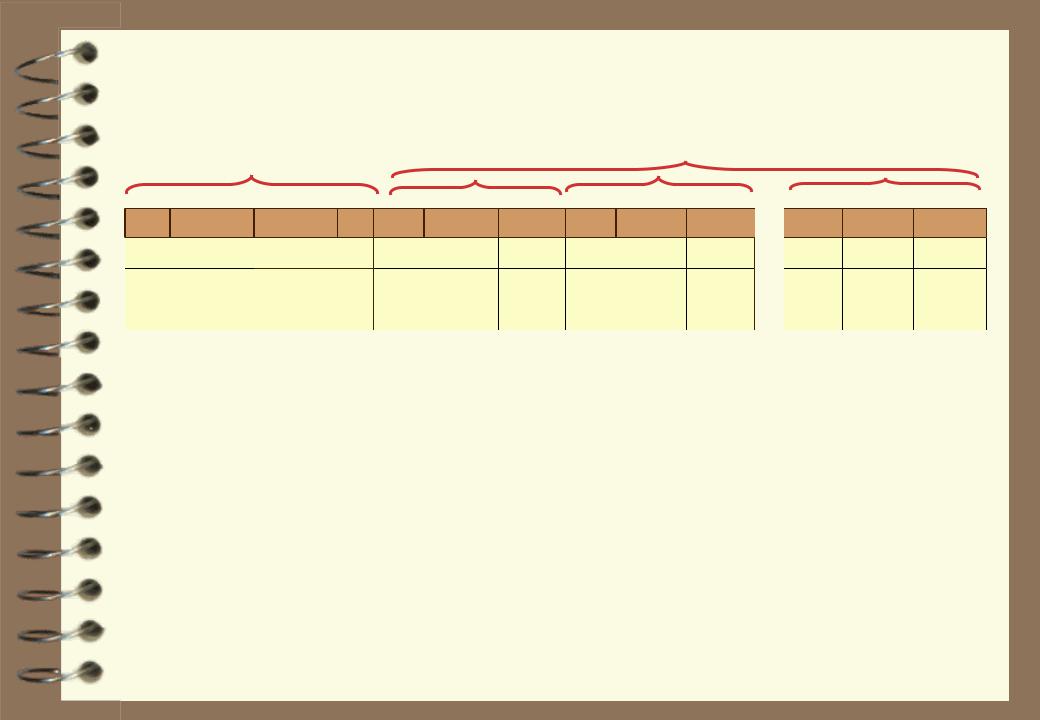
Lecture8. Normalization theory |
|
Sunday 7 July 2019 |
||||
|
|
|
Bad DB design (1) |
|||
|
|
|
|
|
|
|
|
|
|
|
|
|
|
Customers |
|
|
|
|
9 purchases |
|
|
|
|
|
|||
CN |
NAME |
CITY |
… PN1 DATE1 Q-TY1 PN2 DATE2 Q-TY2 … PN9 DATE9 Q-TY9 |
|||
1 |
Ivan |
Kiev |
1 |
21.01 |
20 |
2 23.01 17 |
2 |
Peter |
Odessa |
1 |
26.10 |
25 |
|
3 |
John |
Kiev |
2 |
29.01 |
20 |
|
We have set a limit of 9 purchases. What if a customer has more than 9 purchases?
What to do if purchases are less 9? Set values to NULL?
What to do if it is necessary to delete purchase in the middle of the list?
What we have to do if it is necessary to order cusomers’ orders.
How does search condition look like? For example to find customer that buy parts with No 2?:
CSF NAU |
(PN1 = 2) OR (PN2 = 2) OR (PN3 = 2) ... OR (PN9 = 2) |
4 |
|
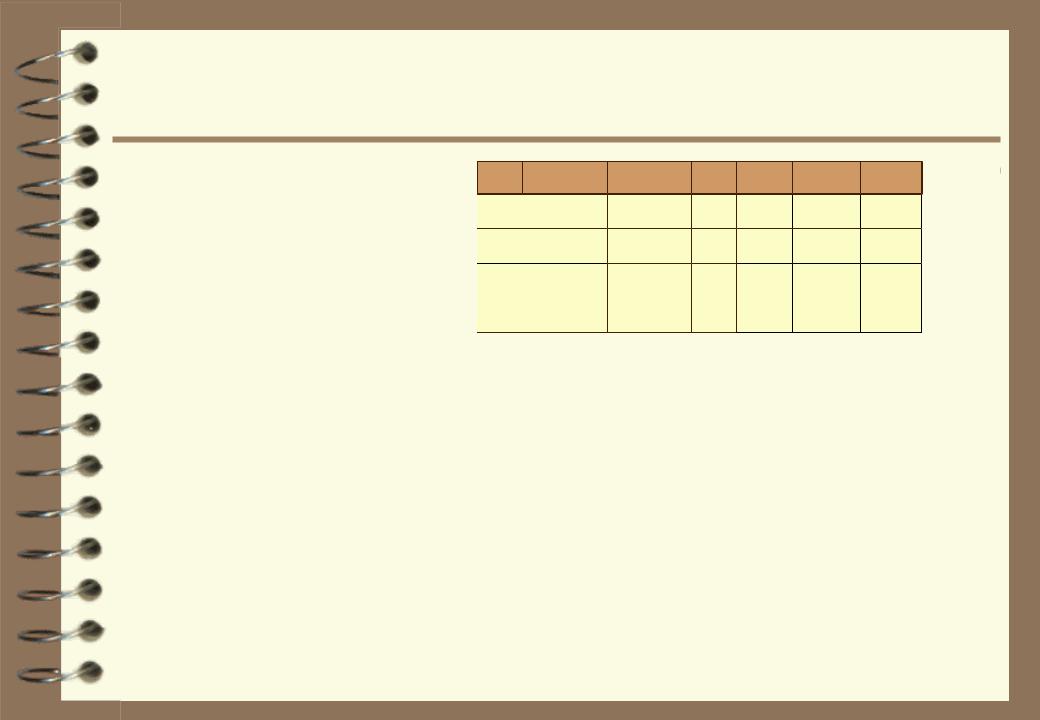
Lecture8. Normalization theory |
Sunday 7 July 2019 |
Bad DB design (2)
CUSTOMER-PURCHASE |
CN |
NAME |
CITY |
… PN |
DATE |
Q-TY |
|
1 |
Ivan |
Kiev |
1 |
21.01 |
20 |
|
1 |
Peter |
Kiev |
2 |
23.01 |
17 |
|
2 |
Peter |
Odessa |
1 |
26.10 |
25 |
|
3 |
John |
Kiev |
2 |
29.01 |
20 |
Insertion anomaly: Data cannot be added because some other data is absent .
Update anomaly: Data inconsistency or loss of data integrity can arise from data redundancy/repetition and partial update .
Deletion anomaly: Data maybe unintentionally lost through the deletion of other data .
Why! It is possible when one relation contains information about two ore more entities of the application domain
CSF NAU |
5 |

Lecture8. Normalization theory |
Sunday 7 July 2019 |
Normalization
Normalization is a step by step reversible process of equivalent transformation of one relational schema into other that has better
characteristics. Every step of such transformation is called normal form.
There are the following unwanted properties of relations and normal forms that remove corresponding properties:
Compound (not atomic) values |
- 1NF |
Not full (partial) functional dependence |
- 2NF |
Transitive functional dependence |
- 3NF |
Multivalued dependence |
- 4NF |
Join dependence |
- 5NF |
CSF NAU |
6 |
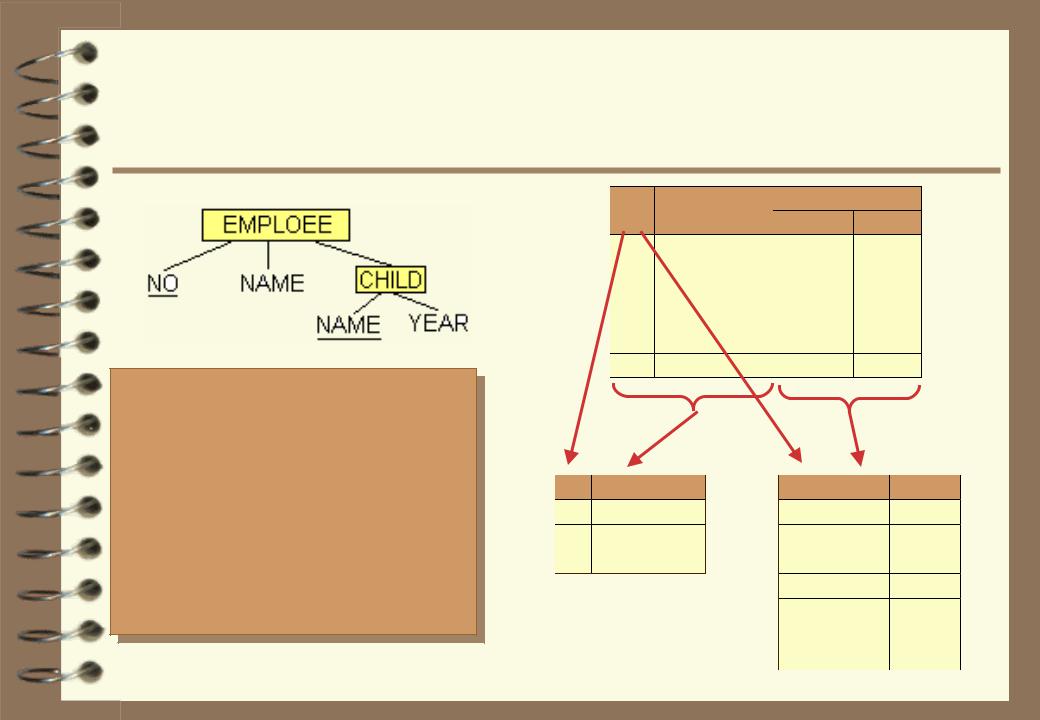
Lecture8. Normalization theory Sunday 7 July 2019
Compound domains and the First Normal Form (1NF)
Relation is in the first normal form (1NF) if all it’s attributes are based on atomic (simple) domains and consequently the values in table cells are
simple (atomic).
Relation is called normalized if it in first normal form .
CSF NAU
EMPLOEE NO |
NAME |
CHILD |
||
NAME |
YEAR |
|||
|
|
|||
1 |
Walton |
Ann |
1987 |
|
Adam |
1979 |
|||
|
|
|||
|
|
|
|
|
|
|
Bernd |
1989 |
|
2 |
Jerome |
Ann |
1991 |
|
3 |
Wilde |
Dan |
1994 |
|
|
|
|||
Clara |
1991 |
|||
EMP- |
NO |
NAME |
CHILD NO |
NAME |
YEAR |
||
LOEE |
1 |
Walton |
|
|
|
|
1987 |
1 |
Ann |
||||||
|
2 |
Jerome |
1 |
Adam |
1979 |
||
|
3 |
Wilde |
2 |
Bernd |
1989 |
||
|
|
|
2 |
Ann |
1991 |
||
|
|
|
2 |
Dan |
1994 |
||
|
|
|
3 |
Clara |
1991 |
||
7

R.A R.B r1 R r2 R (r1 [A] r2 [A] r1 [B] r2 [B])
Lecture8. Normalization theory
Sunday 7 July 2019
Functional dependencies (FD)
Let’s relation R with attributes A and B is given. In relation R attribute B functionally depends on attribute A or A functionally determines B, if
and only if every value of the projection R[A] is linked exactly to one value of the projection R[B]. Such functional dependence is denoted as
R.А R.В.
The set of attributes A is called determinant for the set of attributes B.
Formally FD is defined in such a way :
R.A R.B r1 R r2 R(r1 [A] r2 [A] r1 [B] r2 [B])
The presence of FD is property of the relational schema, but not of instance of relational schema, and reflects semantics of the AD.
The set of FD can be viewed as a set of integrity constraints on the relation scheme; it should be preserved under decomposition.
CSF NAU |
8 |
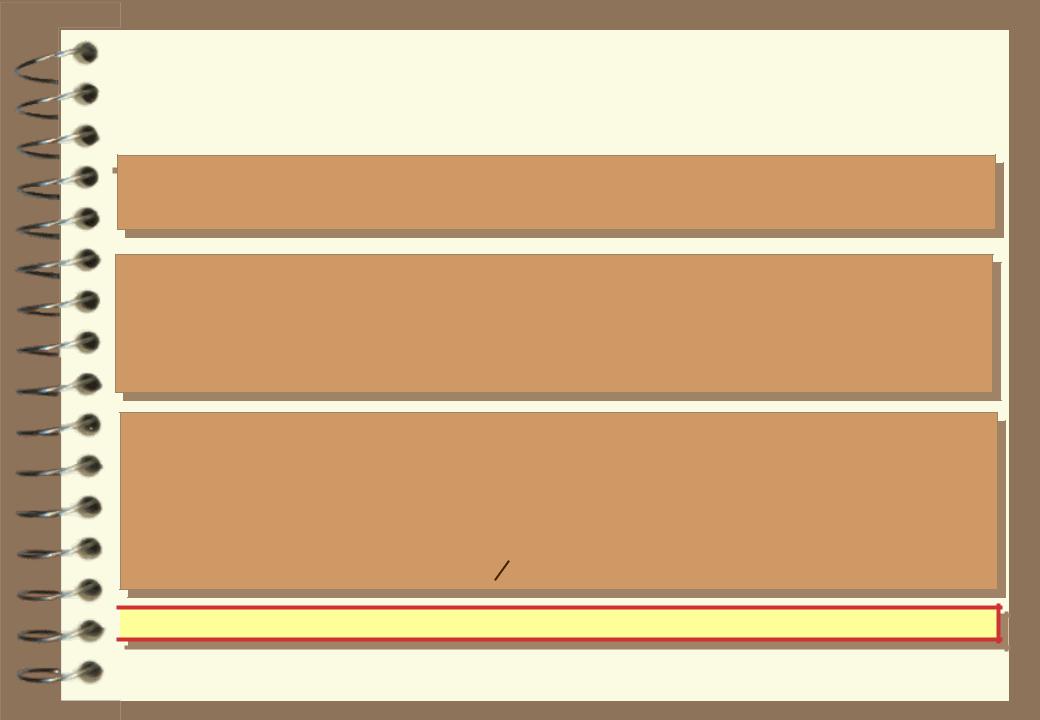
Lecture8. Normalization theory |
Sunday 7 July 2019 |
Keys
Set of attributes K in relation R is called superkey of the relation R if each attribute of the relation R functionally depends on K.
Set of attributes K in relation R is candidate key of the relation R if :
each attribute of the relation R functionally depends on K;
any attribute in K cannot be removed from K without violation of property (a).
It is possible to give the following formal definition of a candidate key. Let М - complete set of attributes of the relation R. The subset of attributes K of the relation R is candidate key, if
А М R.K R.A
К' K B M R.K' R.B

 Assertion: Any relation has candidate key.
Assertion: Any relation has candidate key.
CSF NAU |
9 |
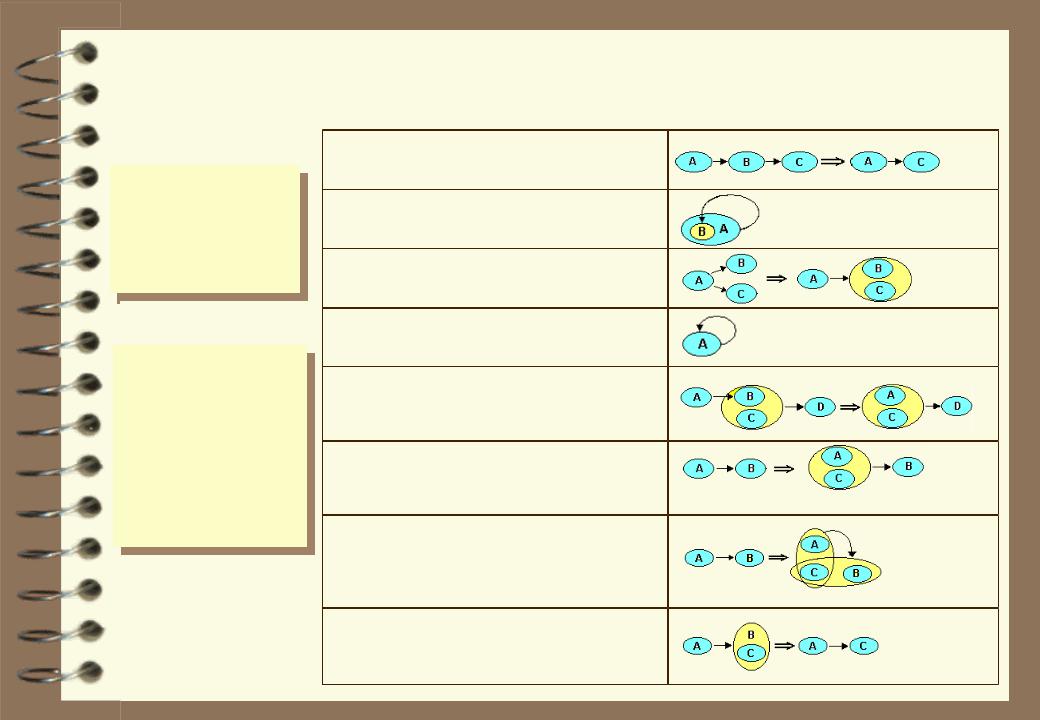
|
|
|
Lecture8. Normalization theory |
Sunday 7 July 2019 |
||||
|
|
|
Properties of functional dependencies |
|||||
|
|
|
|
|
|
1)Transitivity : |
|
|
|
|
|
|
|
|
|
If A B and B C, then A C. |
|
|
|
|
|
|
|
|
|
|
|
|
|
Properties |
|
|
|
|
|
|
|
|
|
2) |
Projectivity: |
|
||
|
|
1), 2), 3) are |
|
|
||||
|
|
Armstrong |
|
|
|
If B A, then A B |
|
|
|
|
|
3) |
Additivity: |
|
|||
|
|
axioms |
|
|
||||
|
|
|
|
|
If A B and A C, then A (B,C) |
|
||
|
|
|
|
|
|
|
|
|
|
|
|
|
|
4) |
Reflexivity: |
|
|
|
|
|
|
|
|
|
A A. |
|
|
|
|
|
|
|
|
|
|
|
|
|
Armstrong’s |
|
|
|
||
|
|
|
5) |
Pseudotransitivity: |
|
|||
|
|
|
|
|
|
|||
|
|
|
axioms are a |
|
|
|||
|
|
|
|
|
If А В and (В,С) D, then |
|
||
|
|
|
sound and |
|
|
(A,C) D |
|
|
|
|
|
complete set |
|
6) |
Continuation: |
|
|
|
|
|
of inference |
|
|
If А В, then (А, С) В |
|
|
|
|
|
|
|
for any attribute С. |
|
||
|
|
|
rules |
|
7) |
Augmentation: |
|
|
|
|
|
|
|
|
|
If А В, then (А, С) (В, С) |
|
|
|
|
|
|
|
|
|
|
|
|
|
|
|
|
|
for any attribute С. |
|
|
|
|
|
|
8) |
Decomposition: |
|
|
|
|
|
CSF NAU |
|
|
If А В and С В, then А С |
10 |
|
|
|
|
|
|
|
|||
